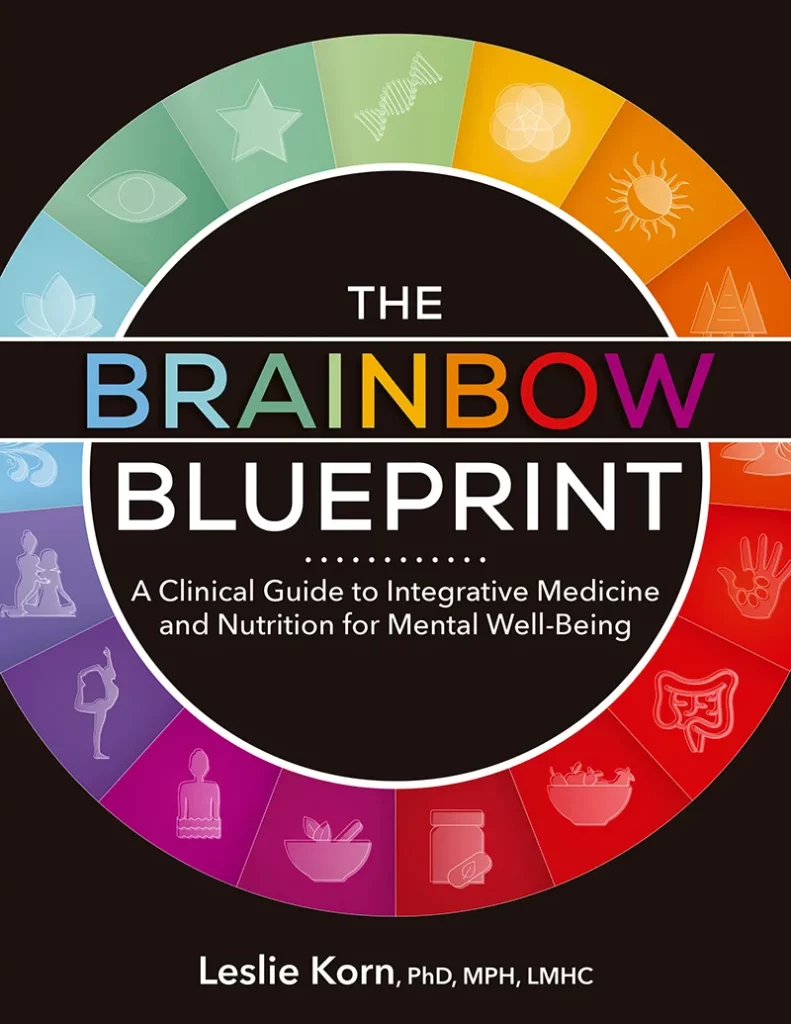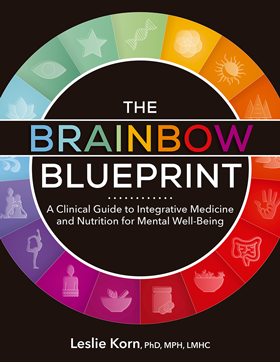
The Brainbow Blueprint: A Clinical Guide to Integrative Medicine and Nutrition for Mental Well-Being
Clients seek the integration of mind, body and spirit, yet mainstream medicine is segmented and focused on disease. This first-of-its-kind book bridges existing treatment gaps with a customizable roadmap toward deep integration that draws from the fields of psychotherapy, biology, nutrition, herbal medicine, somatics, and spirituality.
With step-by-step handouts, done-for-you worksheets, culinary medicine recipes, clinical assessments, and adherence strategies, The Brainbow Blueprint is the comprehensive guide you need to incorporate the emerging and revolutionary field of integrative medicine and nutrition into your practice—and to prime your clients’ capacity for healing.
Order Your Copy of The Brainbow Blueprint®
Claim Your Free Bonus Material
(Food Mood Diary, exercises, client worksheets, etc.)
What This Book Will Teach You
- How to identify the bioindividual needs of your clients so you can tailor your work with them
- The foundational practice of Integrative Assessment
- How to identify and address imbalances in biological rhythms
- The crucial role of digestion in mental health and simple practices for improving it
- The principles of culinary medicine for mental health
- Effective supplements and herbs for a full range of mental health conditions
- Where human/animal relationships can be of benefit to clients
- Breathwork practices and physical exercise options clients will enjoy
- How to use hydrotherapy and detoxification to improve mental health
- What somatic tools and bodywork you can include in your clients’ care plan
- How to explore altered states, spirituality, and meaning-making
- Adherence strategies to ensure long term success
And much more…
Praise
“The Brainbow Blueprint is an integrative masterpiece for any healthcare provider who is interested in supporting their clients’ mental health and wellness. An absolutely brilliant resource for busy clinicians!”

Kathie M. Swift, MS, RDN, LDN, FAND, EBQ
Co-founder of the Integrative and Functional Nutrition Academy
“I love, love, love The Brainbow Blueprint. The US healthcare system is severely ill and Integrative Medicine for Mental Health is desperately needed. The Brainbow Blueprint is the perfect prescription.”

Mary Ann Osborne, DNP, FNP
Integrative Nurse Practitioner
“I absolutely loved The Brainbow Blueprint! This book covers a wide range of areas―including nutrition, psychotherapy, herbal medicine, and much more. Yet it does so in such a practical and approachable style, complete with tangible strategies to improve your life in a holistic way. Whether you’re a client, a therapist, or anyone curious about living a happier and healthier life, you’re sure to love this book!”

Jonah Paquette, PsyD
Author of Happily Even After, Awestruck, and The Happiness Toolbox
“The Brainbow Blueprint fills the gap between traditional mental health training and advancements in integrative treatment methods. Beautifully written and well organized, this book provides the foundations and scripted practices you need to personalize a holistic approach to healing and well-being for your clients. You will find that The Brainbow Blueprint will become your go-to guide.”

Catherine Cook-Cottone, PhD
Author of Embodiment and the Treatment of Eating Disorders
“The integrative model is the new norm for treatment; gone are the days of just talk therapy and medication. Statistics show that the modern client wants more. If you are a social worker struggling to find the most principled and effective way to serve your clients, Dr. Korn’s The Brainbow Blueprint is your new professional compass and guide. I have guided thousands of clients and now clinicians through the Brainbow Model.”

Ilyse B. Keeley LCSW, CMHIMP, CPCC
Certified EMDR and trauma specialist, Certified Integrative Medicine Provider in Mental Health Disorders
“Dr. Leslie Korn has done it once again. In The Brainbow Blueprint she breaks down and integrates the contributing factors of disease, and also offers systematic techniques and practices combined with practical suggestions that makes this book uniquely user-friendly. I highly recommend it for both students in training as well as experienced practitioners of any healing art.”

Dr. Ilene Serlin, BC-DMT
Whole Person Healthcare, Integrated Care for the Traumatized
“The Brainbow Blueprint is a comprehensive and insightful resource for clinicians seeking to expand their therapeutic toolbox with evidence-based integrative and functional medicine practices. Dr. Leslie Korn skillfully introduces complex concepts in an accessible manner, providing a thorough review of the latest research and practical applications of nutrition, mind-body therapies, psychedelic-assisted therapy, and other modalities, accompanied by case studies, treatment protocols, and plenty of user-friendly assessments and worksheets. Emphasizing the importance of a holistic approach to patient care, multidisciplinary collaboration, and genuine compassion for patients’ well-being, this book serves as both an informative guide and an inspiring call to action.”

Linda A. Curran, BCPC, LPC, CAADC, CCDPD
Author of 101 Trauma-Informed Interventions
“Dr. Korn has written a beautifully illustrated book that is useful. It can be read cover to cover or used as a resource with tools, recipes, charts, exercises, and forms for both clinicians and clients to use. I highly recommend adding this book to your shelf to be used as part of your daily practice!”

Vicki Steine, DSc, LCSW, BCHN, IFNCP
Order Your Copy of The Brainbow Blueprint®
Claim Your Free Bonus Material
(Food Mood Diary, exercises, client worksheets, etc.)


More About this Book
“The chapters in this book follow the categories of the Brainbow Blueprint®—a set of modalities that provide clients with a more integrative medical approach to their mental health care.”
Chapter 1 introduces integrative medicine and nutrition for mental health, as well as the Brainbow Blueprint®. It’s the place to get your bearings in this emerging, revolutionary field of natural methods, self- care, and clinical practice.
The remaining chapters focus on specific areas of the Brainbow Blueprint. Though the different areas harmonize and can overlap with each other—the focus is integration, after all—each chapter explores one area of Brainbow practice.
Chapter 2 explores the art and science of bioindividuality, which can help guide your work by allowing you to personalize interventions based on each client’s cultural and genomic profile. Since our individual needs are based on our ancestral heritage, incorporating genomic data that illuminates an individual’s metabolic functioning, detoxification capacities, and nutritional needs will allow you to treat with greater confidence (and your clients will experience better outcomes). This is especially essential because, as you will see, there are several specific genomic profiles that influence mental health and responses to medications.
As an integrative practitioner, your work involves tracing how the varied parts of a client’s life fit together to tell their story, not only emotionally and cognitively, but also through their physical symptoms. Therefore, in chapter 3, I explain how integrative assessment supports your work. I include a comprehensive integrative assessment that you can use as a model as you start to incorporate integrative methods into your practice.
In chapter 4, you’ll learn the latest science on biological rhythms and hormones. Most mental illnesses, including bipolar disorder, post-traumatic stress disorder (PTSD), depression, and seasonal affective disorder, are a major response to the disruption of biological rhythms, like our circadian and ultradian rhythms. Reestablishing these rhythms is an essential tool in restoring mental wellness. Because rhythms drive hormones and hormones drive rhythms, in this chapter I will also explore some basic information about stress hormones and sex hormones, and how these influence mood and well-being at all stages of life.
Our very first medicines came from nature. We remain interdependent with the earth, and we benefit from it in countless ways. Therefore, chapter 5 introduces the role of nature in integrative mental health care and includes an array of ecotherapy techniques that can help virtually anyone in search of healing or reconnection. Simple outdoor activities are a surprisingly powerful means of decreasing anxiety, depression, and stress.
Chapter 6 sheds light on another area that can provide deep healing for people with mental health or physical challenges: human-animal relationships. Here I focus on the science of interspecies connection and discuss how animals can help people heal from the most traumatic experiences. This chapter provides exercises and information to help you learn about different kinds of animal assistants as you consider whether and how you might work with clients who may benefit from this type of intervention.
Chapter 7 provides simple exercises that help you connect the dots between stress, food, digestion, and well-being. In counseling therapies, the aim is to nourish clients with new information and help them “digest” and absorb their insights. The fact that digestion is metaphorical in this way, as well as a literal process, suggests why improving digestion improves mental health. It’s more than mere coincidence that most clients have co-occurring digestive issues!
Once your clients have made the connection between digestion and mental health, chapter 8 focuses on culinary medicine. Here I provide you with the tools to help clients choose food that improves mood and functioning. The benefit of the Brainbow approach to food is that there is no one right diet for everyone, nor is this method ideological. It is based on the science of mental health nutrition and the individual’s needs, rather than the latest fads. This approach espouses body positivity, as all sizes matter.
For clients with underlying nutrient deficiencies or genetic predispositions to certain mental health conditions, culinary medicine works best in concert with nutritional supplementation. Therefore, chapter 9 explains the benefits of using supplements in mental health care and provides guidance on how you can help clients select high-quality supplements as well as check for drug-supplement-herb interactions. I include a template for “supplement smoothies,” for clients who can’t swallow pills, and I provide guidance for parents and providers who want to offer nutritional supplementation for children.
Herbal medicine is considered the “mother” of allopathic medicine and pharmaceuticals. The biochemical effects of herbs are well-documented, but learning to incorporate them into your practice is an organic process. Chapter 10 provides an informational overview of each category of herbs, from adaptogens to stimulants, with information regarding which herbs benefit which client populations and which symptoms. I include reference to a modern drug-herb-nutrient interaction database, along with recipes you can begin to use safely.
While much of this work is concerned with finding ways to better nourish the body and mind with wholesome foods, natural herbs, and select supplements, you must rid the body and brain of problematic toxins and pathogens in order to fully optimize health. Therefore, chapter 11 introduces effective and often enjoyable practices in the area of hydrotherapy and detoxification, and provides a multipronged protocol for clients seeking to reduce their dependence on psychotropic medications.
Chapter 12 is devoted to exercise. Here I provide guidance on how you can better understand the range of associations that clients have with movement and exercise, as well as the range of ways you can better support the inclusion of exercise in integrative health care. I review the five major types of exercise and which kinds are best for which symptoms. I also include a collection of fun, at-home exercises to help clients at a variety of fitness levels and with various wellness targets.
Our bodies are our closest lifelong companions. Yet tuning in to their needs is often quite a challenge because the majority of us are quite used to dissociating and distracting ourselves from the stories our bodies are trying to tell us through symptoms. Chapter 13 provides a set of simple somatic and bodywork practices that can help clients reconnect with their bodies to ground, energize, and deeply relax. I also include recommendations for different kinds of bodywork and how these can vary based on client diagnosis or wellness target.
Breathing is an ever-present, though usually unconscious, aspect of human life. Disordered breathing often co-occurs with mental distress, so in chapter 14, I focus on the breath. I provide a brief assessment for disordered breathing, as well as a range of symptom-specific exercises that have the power to transform mental distress. Healing breathing disorders by making the breath conscious is a potent mental health intervention.
Our beliefs have a foundational power to either heal or worsen our outcomes. In chapter 15, I explore spirituality and meaning-making, including how to engage your clients’ belief systems to catalyze profound psychobiological change. I include exercises that tap into the power of myth and art, the wisdom of dreams, the practice of meditation, and the possibilities of post-traumatic growth.
Chapter 16 discusses altered states and psychedelic medicine. Here I examine the research on a range of psychoactive compounds, provide guidance on harm reduction, and discuss how to educate clients on safely exploring altered states, including dissociation, with the goal of increasing their self-regulation. The burgeoning interest in psychedelic medicine for mental health requires you to become educated about these substances’ medical, psychological, and ritual uses so you can provide evidence-based guidance to clients interested in them.
Even the most well-laid-out Brainbow Blueprint program will not work if the client does not engage in it consistently. Therefore, in chapter 17, I discuss five significant barriers to program adherence and provide you with several adherence strategies to help clients tackle these barriers in a focused, lighthearted, and shame-free way. These strategies will allow you to support clients in defining their priorities, goals, tasks, and timelines.
Given that illness often occurs in the matrix of community (where clients may be exposed to pesticides, pollutants, poor-quality food, poverty, and other factors), in chapter 18 I discuss how to bridge integrative medicine and social justice. I explore how to magnify your impact by making inroads at the community level and provide guidance, drawn from my 45 years of community health care work, to help you provide more personalized care to clients in the context of individual sessions. I also explore large-scale research projects that address the social and political underpinnings of access to integrative health and nutrition.
Finally, chapter 19 focuses on practice development, collaboration, and legal scripts. In this chapter, you will find sample forms and procedures that can support your work and provide a legal and ethical foundation for a healthy practice. You may adapt these as needed in your particular state; note that you may also require consultation with an attorney. I include a sample client protocol and a clinician self-evaluation in this chapter to help you assess your own competency as you decide on a timeline to launch your integrative practice.
About Leslie Korn
Dr. Leslie E. Korn is a pioneer in the treatment of PTSD, complex trauma, and chronic physical illness. Her clinical work, which spans 45 years in private practice and public health, integrates psychotherapy with somatic therapies and a wide range of complementary and alternative medicine. She was a Fulbright scholar in traditional indigenous medicine and an NIH-funded scientist in mind-body medicine.
Order Your Copy of The Brainbow Blueprint®
Claim Your Free Bonus Material
(Food Mood Diary, exercises, client worksheets, etc.)

Claim Your Free Bonus Material…
Included: Client Intake Form, Food-Mood Diary, Exercises, and all Client Worksheets.







